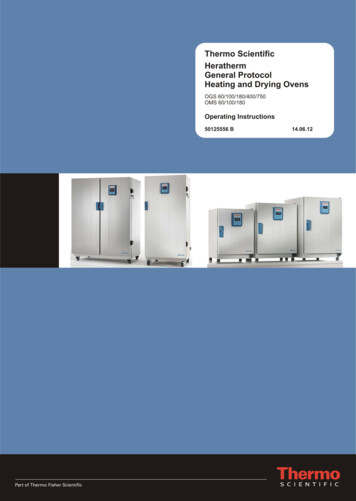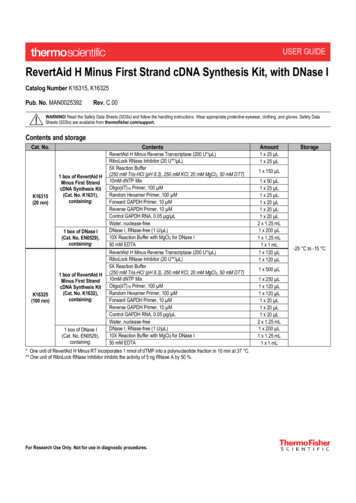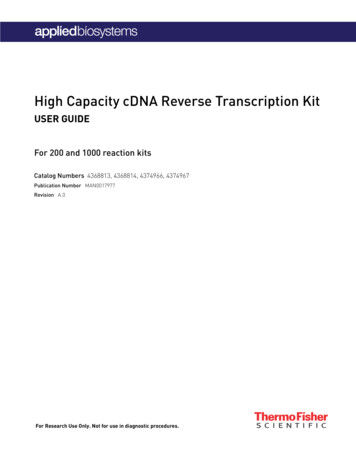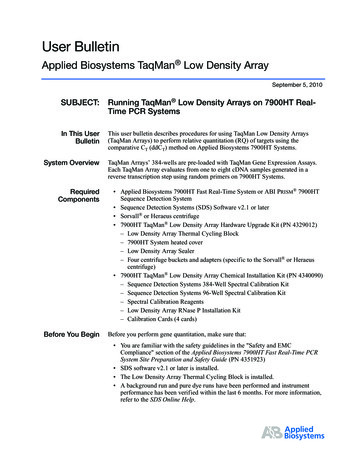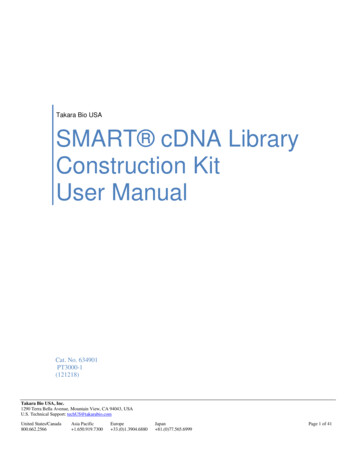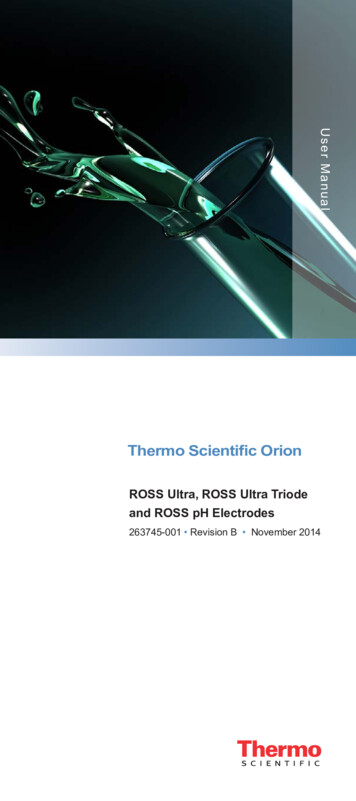
Transcription
Instruction ManualcDNA Synthesis SystemCAT. NO. 18267-013
Table of Contents1. Notices to Customer . . . . . . . . . . . . . . . . . . . . . . . . . . . . . . . . . . . . . . . .11.1 Important Information . . . . . . . . . . . . . . . . . . . . . . . . . . . . . . . . . . . . . . . . . . . . .11.2 Precautions . . . . . . . . . . . . . . . . . . . . . . . . . . . . . . . . . . . . . . . . . . . . . . . . . . . . .12. Overview . . . . . . . . . . . . . . . . . . . . . . . . . . . . . . . . . . . . . . . . . . . . . . . . . . .22.12.22.32.42.52.6The cDNA Synthesis System . . . . . . . . . . . . . . . . . . . . . . . . . . . . . . . . . . . . . . .2cDNA Libraries . . . . . . . . . . . . . . . . . . . . . . . . . . . . . . . . . . . . . . . . . . . . . . . . . .2Choosing a Vector System . . . . . . . . . . . . . . . . . . . . . . . . . . . . . . . . . . . . . . . . .3mRNA Purification . . . . . . . . . . . . . . . . . . . . . . . . . . . . . . . . . . . . . . . . . . . . . . . .4cDNA Synthesis: The First Strand Reaction . . . . . . . . . . . . . . . . . . . . . . . . . . .4cDNA Synthesis: The Second Strand Reaction . . . . . . . . . . . . . . . . . . . . . . . .42.6.1 Hairpin-Primed Synthesis . . . . . . . . . . . . . . . . . . . . . . . . . . . . . . . . . . . . .52.6.2 Okayama and Berg Procedure . . . . . . . . . . . . . . . . . . . . . . . . . . . . . . . . .62.6.3 Gubler and Hoffman Procedure . . . . . . . . . . . . . . . . . . . . . . . . . . . . . . . .62.7 cDNA Synthesis System: Modification of the Gubler and . . . . . . . . . . . . . . . .7Hoffman Procedure2.7.1 First Strand Reaction . . . . . . . . . . . . . . . . . . . . . . . . . . . . . . . . . . . . . . . . .72.7.2 Second Strand Reaction . . . . . . . . . . . . . . . . . . . . . . . . . . . . . . . . . . . . . .72.8 Cloning Double-Stranded cDNA . . . . . . . . . . . . . . . . . . . . . . . . . . . . . . . . . . .102.8.1 Tailing with Terminal Transferase . . . . . . . . . . . . . . . . . . . . . . . . . . . . .102.8.2 Blunt-End Ligation . . . . . . . . . . . . . . . . . . . . . . . . . . . . . . . . . . . . . . . . . .102.8.3 Addition of Linkers . . . . . . . . . . . . . . . . . . . . . . . . . . . . . . . . . . . . . . . . . .103. Methods . . . . . . . . . . . . . . . . . . . . . . . . . . . . . . . . . . . . . . . . . . . . . . . . . . .113.1 Components . . . . . . . . . . . . . . . . . . . . . . . . . . . . . . . . . . . . . . . . . . . . . . . . . . .113.2 mRNA Purification . . . . . . . . . . . . . . . . . . . . . . . . . . . . . . . . . . . . . . . . . . . . . .113.3 General Comments . . . . . . . . . . . . . . . . . . . . . . . . . . . . . . . . . . . . . . . . . . . . .123.3.1 First Strand Reaction . . . . . . . . . . . . . . . . . . . . . . . . . . . . . . . . . . . . . . .143.3.2 Second Strand Reaction . . . . . . . . . . . . . . . . . . . . . . . . . . . . . . . . . . . . .143.4 Advance Preparations . . . . . . . . . . . . . . . . . . . . . . . . . . . . . . . . . . . . . . . . . . .143.4.1 First Strand Reaction . . . . . . . . . . . . . . . . . . . . . . . . . . . . . . . . . . . . . . .143.4.2 Second Strand Reaction . . . . . . . . . . . . . . . . . . . . . . . . . . . . . . . . . . . . .153.5 First Strand Synthesis . . . . . . . . . . . . . . . . . . . . . . . . . . . . . . . . . . . . . . . . . . .153.6 Second Strand Synthesis . . . . . . . . . . . . . . . . . . . . . . . . . . . . . . . . . . . . . . . . .163.6.1 Protocol 1: cDNA Synthesis for Linker Addition . . . . . . . . . . . . . . . . . . .163.6.2 Protocol 2: cDNA Synthesis for Tailing . . . . . . . . . . . . . . . . . . . . . . . . .173.7 Analysis of the cDNA Products . . . . . . . . . . . . . . . . . . . . . . . . . . . . . . . . . . . .193.7.1 First Strand Yield . . . . . . . . . . . . . . . . . . . . . . . . . . . . . . . . . . . . . . . . . . .193.7.2 Second Strand Yield . . . . . . . . . . . . . . . . . . . . . . . . . . . . . . . . . . . . . . . .193.7.3 Amount Recovered after RNase H Digestion . . . . . . . . . . . . . . . . . . . .203.7.4 Gel Analysis . . . . . . . . . . . . . . . . . . . . . . . . . . . . . . . . . . . . . . . . . . . . . . .203.7.5 Advance Preparations . . . . . . . . . . . . . . . . . . . . . . . . . . . . . . . . . . . . . . .20i
Table ofContents3.7.6 Procedure . . . . . . . . . . . . . . . . . . . . . . . . . . . . . . . . . . . . . . . . . . . . . . . .214. Troubleshooting . . . . . . . . . . . . . . . . . . . . . . . . . . . . . . . . . . . . . . . . . .224.14.24.34.4mRNA Purification . . . . . . . . . . . . . . . . . . . . . . . . . . . . . . . . . . . . . . . . . . . . . .22First Strand Reaction . . . . . . . . . . . . . . . . . . . . . . . . . . . . . . . . . . . . . . . . . . . .22Second Strand Reaction . . . . . . . . . . . . . . . . . . . . . . . . . . . . . . . . . . . . . . . . .23General Guidelines . . . . . . . . . . . . . . . . . . . . . . . . . . . . . . . . . . . . . . . . . . . . . .245. References . . . . . . . . . . . . . . . . . . . . . . . . . . . . . . . . . . . . . . . . . . . . . . . .256. Related Products . . . . . . . . . . . . . . . . . . . . . . . . . . . . . . . . . . . . . . . . . .26Figures1.2.3.4.5.Outline of Procedures for the cDNA Synthesis System . . . . . . . . . . . . . . . . . .2Hairpin-Primed cDNA Synthesis . . . . . . . . . . . . . . . . . . . . . . . . . . . . . . . . . . . .5Second Strand Synthesis . . . . . . . . . . . . . . . . . . . . . . . . . . . . . . . . . . . . . . . . . .6Comparison of Second Strand Procedures Using the cDNASynthesis System . . . . . . . . . . . . . . . . . . . . . . . . . . . . . . . . . . . . . . . . . . . . . .8Protocol Flow Diagram . . . . . . . . . . . . . . . . . . . . . . . . . . . . . . . . . . . . . . . . . . .13 DH5α , DH5α FT , DH10B , ELECTROMAX , GENETRAPPER , MESSAGEMAKER , FOCUS , MAX EFFICIENCY ,SM SUPERSCRIPT , TECH-LINE , and ULTRAMAX are marks of Invitrogen Corporation.RNASEAWAY is a trademark of Molecular Bio-Products, Inc.TRIZOl is a registered trademark of Molecular Research Center, Inc.ii
Notices to Customer11.1 Important InformationThis product is authorized for laboratory research use only. The product has notbeen qualified or found safe and effective for any human or animal diagnostic ortherapeutic application. Uses for other than the labeled intended use may be aviolation of applicable law.1.2 PrecautionsWarning: This product contains hazardous reagents. It is the end-user’sresponsibility to consult the applicable MSDS(s) before using this product. Disposalof waste organics, acids, bases, and radioactive materials must comply with allappropriate federal, state, and local regulations. If you have any questionsconcerning the hazards associated with this product, please call the InvitrogenEnvironmental Health and Safety Chemical Emergency hotline at (301) 431-8585.1
2Overview2.1The cDNA Synthesis SystemThe cDNA Synthesis System provides the materials needed to rapidly and reliablysynthesize double-stranded cDNA from mRNA. It uses cloned Moloney MurineLeukemia Virus (M-MLV) reverse transcriptase to synthesize first strand cDNA froman mRNA population. Figure 1 is a summary of the two procedures that may beused to prepare double-stranded cDNA for tailing or linker addition. The one-tubesystem allows second strand cDNA to be synthesized immediately after the firststrand reaction, thereby improving the yield of double-stranded cDNA by eliminatingextraction and precipitation between steps. Furthermore, the double-stranded cDNAcan be cloned into either plasmid or bacteriophage vectors.mRNACloned M-MLVReverse TranscriptaseFirst Strand cDNAProcedure IDNA Polymerase IRNase HDNA LigaseSecond Strand cDNAProcedure IIDNA Polymerase IDNA LigaseSecond Strand cDNARNase Hds cDNA foruse with linkersds cDNA forhomopolymer tailingFigure 1. Outline of procedures for the cDNA Synthesis System.2.2cDNA LibrariesBacteria or bacteriophage containing cDNA copies of an mRNA populationconstitute a cDNA library. A good library should be large enough to containrepresentatives of all sequences of interest, and the cDNA inserts should be fulllength copies of the original mRNA. Sequences at both the 5 and 3 ends ofmRNAs contain valuable information needed for full understanding of geneexpression and processing.2
Construction of a cDNA library from mRNAs is an essential step for many studies inmolecular biology. A cDNA clone isolated from a cDNA library provides a means ofestablishing the fully processed form of a message initially transcribed from agenomic sequence containing intervening sequences (introns). It also provides aprobe for examining the structure of the gene, determining its location in thegenome, or developing in vitro or recombinant expression systems. Comparing twolibraries constructed from different tissues or different stages of a developmentalsystem can reveal developmentally regulated genes. For these and other types ofstudies, a high quality library is critical.2Many procedures for synthesizing cDNA have been developed, most attempting tomaximize the amount of cDNA produced from a limited amount of mRNA. In most ofthese procedures, the completeness of the cDNA synthesis is variable andunpredictable. This variation can enter in any of the three steps of cDNA synthesis:mRNA isolation, first strand cDNA synthesis, and second strand cDNA synthesis.The quality of the mRNA preparation, the purity of the enzyme and reagents used inthe first strand reaction, and the choice of second strand method affect the quantityof sequence information retained in the library.2.3Choosing a Vector SystemTwo types of vectors are in general use for cDNA cloning in E. coli: plasmids andbacteriophage lambda derivatives. A number of factors affect the choice of vector,which in turn affects the method of cDNA synthesis. In choosing a vector, considerthe following:1.2.3.4.How many clones are needed to provide a reasonable chance of findingthe gene of interest?How critical is it to have a complete copy of the mRNA containing the 5 end of the message?How important is it to obtain a clone that can express a protein product?How familiar and comfortable are you with the manipulation andpropagation of plasmids or phage?The number of clones needed to make a library complete depends upon the relativeabundance of the target mRNA in the total mRNA pool (1). Therefore, it is advantageous to use an enriched source of the target mRNA if possible. The enrichmentcan be biological (as in the case of a developmentally regulated gene) or physical(hybrid selection or immunoprecipitation). The size of a library needed to obtain anmRNA as a cDNA clone generally requires 104 to 105 recombinants (1). Eitherplasmids or phage vectors can yield this number of clones; however, the efficiencyof cloning with phage vectors is generally higher and requires less mRNA initially.The method used to synthesize the double-stranded cDNAs will influence theamount of sequence information at the 5 end of the mRNAs that is preserved in thecDNA library (2). Plasmids are superior to phage if this is an importantconsideration. If the cDNA library is created in phage (figure 1, Protocol 1), the useof molecular linkers results in loss of sequence information at the 5 ends of themRNAs. On the other hand, if cDNAs are cloned into plasmids using homopolymerictails, the conditions for cDNA synthesis with the cDNA Synthesis System (figure 1,Protocol 2) are designed to conserve all or most of the sequence information at the5 termini. In addition, the method used to insert double-stranded cDNAs into avector can influence the amount of sequence information that becomes establishedin the library when cloning large inserts. This is discussed later in Section 2.6,Second Strand Reaction.If the cDNA library is to be screened with an antibody, phage vectors provide thebest system for regulated expression of antigen and ease of screening (3). Althoughplasmid-based libraries can be used (4), they are more cumbersome andconsiderably more tedious to use. Choosing between plasmid and phage vectors3
Overviewbecomes more difficult if a library will be screened with a nucleic acid probebecause the technology is equivalent in both systems (5,6). In this case, otherconsiderations will weigh more heavily in the decision.Cloning into plasmids is generally easier for the novice because it requires lessmanipulation of the double-stranded cDNA. It also avoids the problems that can beencountered when propagating phage. However, this should not preclude usingphage if it is the best choice. Numerous references describe cDNA cloning intophage in detail, and these should be consulted (7,8).2.4mRNA PurificationThe quality of the mRNA dictates the maximum amount of sequence informationpreserved during synthesis of double-stranded cDNA. The most prevalent sourceof ribonuclease (RNase) contamination is the starting material used for the mRNApurification. The endogenous RNases must be inactivated quickly during lysis ofthe cells. This often is accomplished by using protein denaturants such as phenol,chloroform, sodium dodecyl sulfate, or chaotropic salts (9,10). The rigor of theconditions needed to prevent degradation can vary with the source of the RNA.It is also possible to introduce RNases into a preparation of RNA by usingcontaminated reagents, enzymes, or laboratory ware. Microbial contamination ofbuffers can cause serious problems. We recommend that you maintain sterilestocks and practice sound microbiological technique. A common source of RNaseis labware that has been used for RNase digestions and circulated among generallaboratory equipment without prior decontamination. All glass and plasticware usedfor mRNA purification should be dedicated to this purpose to avoid contamination.After the RNA has been deproteinized and rendered RNase free, it is fractionatedby chromatography on a matrix such as oligo(dT) cellulose (11). The RNA thatbinds to the column is enriched for RNAs containing poly(A) tails. This eliminatesrRNA contaminants and partially degraded mRNAs that lack poly (A) at the 3 terminus. A successful oligo(dT) cellulose purification results in higher yields of firststrand cDNA and less spurious copying of nonmessenger RNAs.2.5cDNA Synthesis: The First Strand ReactionThe classical conditions for the reverse transcription of RNA derive entirely fromwork with the Avian Myeloblastosis Viral (AMV) reverse transcriptase. This enzymehas been used extensively and its reaction parameters exhaustively documented(12). Available preparations of this enzyme are of variable quality, causingfluctuations in the quantity and quality of the first strand cDNA. The source of thisvariation is probably due to the level of contaminating RNase. As the RNasecontamination becomes more severe, the first strand cDNAs will be shorterbecause the RNA template is degraded during first strand synthesis. In cases ofextreme contamination, the yield of first strand cDNA will also decline as the size ofthe cDNA drops below the threshold of acid insolubility.An array of modifications and additions to the first strand reaction have beenreported to improve the quality and yield of cDNA; some of these are attempts toreduce the effect of RNase contamination. The cDNA Synthesis System relies on acloned enzyme, M-MLV reverse transcriptase. Cloned and overexpressed in E. coli(13), M-MLV reverse transcriptase is rigorously purified and does not requireadditional components to synthesize high quality first strand cDNA.2.6cDNA Synthesis: The Second Strand ReactionMany procedures for second strand synthesis have been developed. The mainfeatures of three commonly used methods are discussed briefly to facilitate your4
understanding of the second strand conditions in the cDNA Synthesis System.2.6.1Hairpin-Primed SynthesisThe earliest procedure (14) for priming second strand synthesis relied on the abilityof AMV reverse transcriptase to randomly initiate the formation of hairpin loops atthe 3 end of the first strand cDNA (figure 2). The mechanism for generation of thehairpin is believed to depend upon the action of the endogenous RNase H activity ofAMV reverse transcriptase: as the RNA template is being reverse transcribed, it isalso being degraded by the RNase H. When the RNA at the 5 end of the messagehas been degraded, the exposed, single-stranded cDNA at the 3 end can fold backupon itself in a transient manner and provide a priming point for the reversetranscriptase to initiate second strand synthesis. Although this procedure is simpleto perform, it is the most unpredictable because the priming event occurs randomlyalong the mRNA template. Furthermore, the 3 hairpin is stabilized by elongationmRNA: 5' m7GpppFirstStrand cDNA:2An 3'(dT)12-18 5'Primer3'Alkaline Hydrolysisof RNA Template3'Formation of transienthairpin primers by firststrand cDNA(dT)12-18 5'DNA Polymerase ISynthesis of secondstrand cDNA by DNAPolymerase I usingthe hairpin primer3'(dT)12-18 5'S1 NucleaseHydrolysis of hairpin byS1 Nuclease and loss ofsequence information5'(dA)n 3'3'(dT)n 5'Key:: mRNA: First or second strand cDNA: cDNA potentially lost during thecloning procedureFigure 2. Hairpin-primed cDNA synthesis.5
Overviewand must be cleaved with S1 nuclease to make it amenable to cloning. This is yetanother point at which sequence information can be lost from the cDNA population.2.6.2Okayama and Berg ProcedureA major improvement in double-stranded cDNA synthesis was based upon aninnovative method for generating primers for second strand synthesis (15). Ratherthan relying upon reverse transcriptase to initiate from a hairpin primer, the mRNA isused to prime synthesis by E. coli DNA polymerase I after the mRNA is nickedrandomly. The nicks are introduced by the action of E. coli RNase H, and the RNA isreplaced in a nick translation reaction catalyzed by E. coli DNA polymerase I.Okayama and Berg exploited this methodology and designed a specialized, two-partplasmid cloning vector to preserve as much sequence information at the 5 end ofthe RNA as possible. Although their technique is elegant, it is relatively complex andcan be applied readily only to plasmid cloning vectors. This excludes a large groupof researchers that would like to clone into bacteriophage lambda.2.6.3Gubler and Hoffman ProcedureIt is possible to combine the classical oligo(dT) primed synthesis of first strand withthe Okayama and Berg second strand reaction conditions to produce a method thatis more versatile than either alone (figure 3; 16). The Gubler and Hoffman methoddoes not require the elaborate two-part cloning vector of Okayama and Berg or theFirst strand reactionAdd E. coli DNA Polymerase I,RNase H, and DNA LigaseHHHHThe mRNA, already containing 5'nicks and gaps from the3'endogenous RNase H of thereverse transcriptase, is furthernicked by E. Coli RNase H3'Polymerase I initiatessecond strand synthesisby nick translation5'3'3'5'5'LE. coli DNA ligase sealsany breaks left in thesecond strand cDNA5'3'3'5'Final ds cDNA product5'3'3'5'Key:: mRNA: First or second strand cDNAHL: E. coli RNase H: E. coli DNA LigaseFigure 3. Second strand synthesis.6
use of nuclease S1. Although some sequence information at the 5 end of the RNAis usually lost by this method, the amount is minor compared to hairpin-primed/S1digested second strand synthesis.2.7cDNA Synthesis System: Modification of the Gubler andHoffman Procedure2A one-tube double-stranded cDNA synthesis system has been designed using MMLV reverse transcriptase for first strand synthesis. Based on the Gubler andHoffman procedure, the one-tube concept minimizes manipulations and improvesthe chances of constructing a library successfully. Using model RNAs as templates,we have optimized the reaction conditions of the cDNA Synthesis System tomaximize length and yield of double-stranded cDNAs.2.7.1First Strand ReactionThe conditions for the first strand reaction are similar to the conditions firstrecommended for the use of M-MLV reverse transcriptase (17). However, actinomycin D (an inhibitor of second strand synthesis) is not added to the reaction. Usingthe conditions described in this manual, M-MLV reverse transcriptase does nothydrolyze sufficient mRNA to allow significant hairpin formation at the 3 end of thefirst strand cDNA. Furthermore M-MLV reverse transcriptase does not use hairpinsefficiently as a primer for initiating second strand synthesis. These properties of MMLV reverse transcriptase are important for two reasons: second strand synthesiscan be performed in the same tube as the first strand reaction without resorting toan intermediate extraction and precipitation, and the amount of sequence information lost from the library because of hairpin-primed second strand synthesis isminimized.2.7.2Second Strand ReactionM-MLV reverse transcriptase contains an endogenous RNase H activity (18). Thisactivity initially generates oligomers of 20 to 30 nucleotides on model RNA:DNAsubstrates, and with extended incubations, smaller digestion products 2 to 20nucleotides long begin to appear (18). Thus, it is likely that the RNA portion of theRNA:cDNA duplex is both nicked and gapped following first strand synthesis.However, under the conditions that we describe for first strand synthesis, a significant number of the 5 -most RNA oligomers survive the RNase H activity of the MMLV reverse transcriptase and serve as primers for near full-length second strandcDNAs synthesized by E. coli DNA polymerase I.Second strand synthesis with E. coli DNA polymerase I can be performed with orwithout E. coli RNase H: the amount of sequence information retained at the end ofthe double-stranded cDNA that corresponds to the 5 end of the message isaffected by this choice. This is due to the multiple activities of the polymerase I. Inaddition to its polymerase activity, polymerase I is both a 5 and 3 exonuclease(19). The 5 exonuclease activity allows polymerase I to replace a DNA strand in thenick translation reaction, degrading the strand in the 5 to 3 direction while the polymerase activity replaces the strand in the same direction. The 5 exonuclease alsofunctions as an RNase H exonuclease (19) and can degrade the RNA portion of anRNA:DNA hybrid. However, the blunt end of an RNA:DNA hybrid is not degraded bythe RNase H activity of polymerase I.The cDNA Synthesis System can be used to produce double-stranded cDNA by twoprocedures. In Protocol 1 (figure 4), E. coli RNase H is included in the secondstrand reaction. The E. coli RNase H is an endonuclease (20) that will attack theRNA:DNA hybrid in a random fashion, producing nicks in addition to those producedby the reverse transcriptase. If enough additional nicks are introduced into the RNAat the 5 end of the message before second strand synthesis commences, fragments may be produced that are too short to remain hybridized; thus, they will notbe able to serve as primers. In addition, the 5 -most RNA oligomer that primessecond strand DNA synthesis will continue to be degraded until only two ribonucleotides remain at the 5 end of the second strand DNA (2). These are substrates for7
OverviewProcedure IIProcedure I5'-most nick introduced byM-MLV reverse transcriptaseduring first strand synthesism7Gpppm7GpppH H H HAdd DNAPolymerase IAdd DNAPolymerase IAdd RNase HAdd DNA LigaseAdd DNA Ligasem7Gpppm7GpppPm7GpppRemove DNAPolymerase I andDNA LigasePAdd RNase HH H H Hm7GpppEnd product is ds cDNA whichhas lost sequence informationat the 5' end of the mRNA;generally 10-20 nucleotidesAdditionalsteps for linkeradditionEnd product is ds cDNA whichhas retained the sequenceinformation at the 5' end ofthe mRNAAddition of tailsKey:: mRNAH : RNase H: First or second strand cDNAP : 5' 3' exonucleaseof DNA Polymerase I: 3' 5' exonucleaseP of DNA Polymerase I: DNA representing sequenceinformation originally at the 5'end of the mRNAFigure 4. Comparison of second strand procedures using the cDNA synthesis system.8
the polymerase I RNase H activity, and the remaining ribonucleotides will beremoved. This also leaves the 3 end of the first strand cDNA single stranded,making it a substrate for the 3 exonuclease activity of polymerase I. The 3 exonuclease of the polymerase I degrades this strand to, or very near to, a blunt end.The result is a population of cDNAs that are blunt ended (or nearly so) and thathave lost some of the sequence information originally encoded in the 5 end of themRNA. The amount of sequence lost is random and corresponds to the length ofthe 5 -most RNA oligonucleotide that primed the second strand reaction. Therefore,activities of the enzymes used in Protocol 1 ensure loss of some information at the5 end of the RNA. For full-length cDNAs synthesized with M-MLV reversetranscriptase, this will generally be 10 to 20 nucleotides (2).2An alternate method, which retains more of the sequence information at the 5 endof the RNA, is described in Protocol 2 (figure 4). In this case, the second strandreaction contains only DNA polymerase I. Thus, the sole priming points will be thenicks introduced by the reverse transcriptase during the first strand reaction. SinceM-MLV reverse transcriptase will produce nicks 10 to 20 bases from the 5 end ofthe RNA in the hybrid (2), these will provide the 5 -most initiation points for secondstrand synthesis. If the DNA polymerase I has removed all of the internal RNAprimers between the 5 terminus of the RNA and its poly(A) tail by nick translation,the result will be a duplex that is entirely DNA (except for the surviving capped RNA5 oligonucleotide).Since the loss of sequence information that occurs in Protocol 1 begins with thehydrolysis of the 5 -most primer RNA by E. coli RNase H, when the second strand issynthesized in its absence, the 3 terminus of the first strand cDNA is protected fromthe 3 exonucleolytic activity of the polymerase I. If these molecules are tailed withterminal transferase and cloned into a plasmid, the sequence information at the 5 end of the RNA will be reclaimed when the single-stranded stretch of the first strandcDNA is repaired in vivo. This method gives the same result as the Okayama andBerg protocol, but it does not require specialized DNAs. If E. coli RNase H is addedafter removal of the DNA polymerase I, the number of clones containing full-lengthinserts rises several fold.For RNAs 1 to 2 kb long, Protocol 2 and homopolymeric tailing help retain the mostsequence information. For larger mRNAs, Protocol 1 and linker addition are moreeffective because the sequence nearest the 3 end of the mRNA is more likely to bedeleted by tailing as the length of the mRNA increases (2).Deletion of the sequence nearest the 3 end of the mRNA is caused by internal andexternal tails competing for hybridization to the vector. Discontinuities in the secondstrand cDNA can provide sites for tailing, and double-stranded cDNA transcribedfrom a long template may be tailed at one or more internal positions within thesecond strand in addition to its true 3 end. Thus, when the tailed double-strandedcDNA is annealed with a vector, the internal tails in the second strand can competewith the tail at the true 3 terminus for hybridization to the vector. When hybridizationto the vector occurs at an internally tailed site, sequence in the double-strandedcDNA between the hybridized tail and the true 3 terminus of the second strandcDNA is lost during in vivo repair and replication of the plasmid after transformationinto bacteria. The result is preferential cloning of the ds cDNA sequence derivedfrom the 5 region of the mRNA.In experiments performed at Invitrogen using either procedure with a 6.2-kb RNA asthe substrate, approximately 20% of the clones examined were near full length(contained sequences corresponding to within 35 nucleotides of the 5 terminus ofthe RNA), yet none were greater than 4 kb long (2). This result did not changesignificantly when the DNA ligase was omitted, implying that many internal 3 terminiin the second strand cDNA are not substrates for this enzyme. In contrast, additionof molecular linkers to double-stranded cDNA prepared by Protocol 1 from the 6.2-9
Overviewkb RNA yielded a large proportion (40%) of clones containing inserts withoutdetectable deletions (2). Thus, when cloning double-stranded cDNA copies of longmRNAs, synthesize the double-stranded cDNA by Protocol 1 and convert the endsto cohesive termini using molecular linkers.2.8Cloning Double-Stranded cDNAOnce the double-stranded cDNA has been synthesized successfully, it must beconverted into a form that can be cloned. Further manipulation of the doublestranded cDNA will depend upon the type of cloning vector chosen. Three principalmethods are used to prepare the double-stranded cDNA for cloning: tailing, repair ofthe termini to blunt ends, and addition of molecular linkers. Detailed protocols forcloning into plasmids (1,8,21) or bacteriophage (7,8) should be consulted.2.8.1Tailing with Terminal TransferaseOne of the most popular methods for insertion of a cDNA into a plasmid is theaddition of homopolymer tails to the DNA using terminal deoxynucleotidyltransferase (22,23). This method is fast and relatively simple. When dC tails of 20 to30 nucleotides are added to the 3 ends of the double-stranded cDNA, the cDNAcan be annealed to a vector that has been linearized and tailed with dGTP. Theseannealed molecules do not need to be ligated and will transform E. coli. If the vectoris linearized at a Pst I site and tailed with dGTP, the restriction endonuclease site isrestored after repair in vivo. Thus, the cloned fragments can be excised with Pst I.The cDNA prepared by either of the methods in this manual can be tailed andcloned into a dG-tailed vector, but we recommend Protocol 2 for preparing cDNA tobe cloned by tailing. The cDNA prepared in this manner will retain the greatestamount of sequence information originally encoded at the 5
terminus. A successful oligo(dT) cellulose purification results in higher yields of first strand cDNA and less spurious copying of nonmessenger RNAs. 2.5 cDNA Synthesis: The First Strand Reaction The classical conditions for the reverse transcription of RNA derive entirely from work with the Avian Myeloblastosis Viral (AMV) reverse transcriptase.
